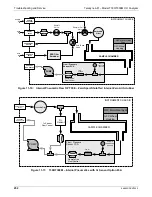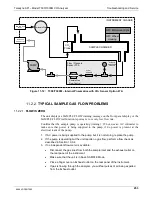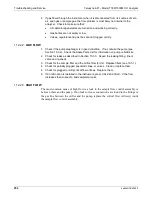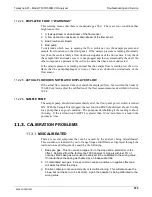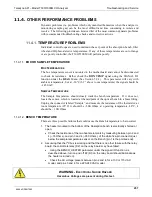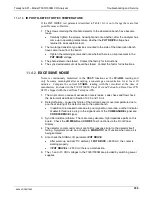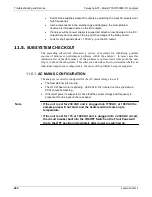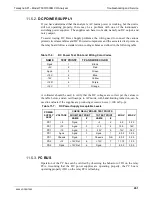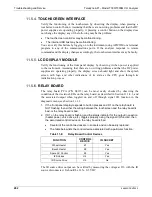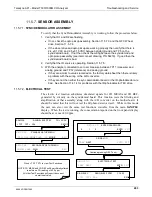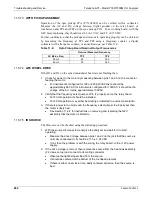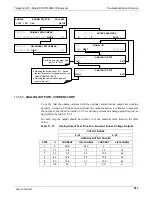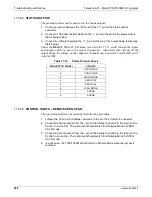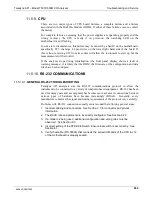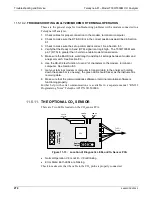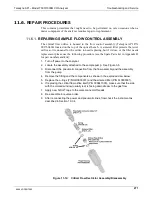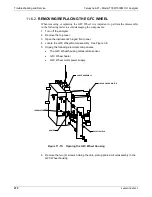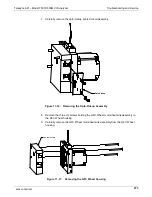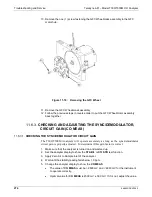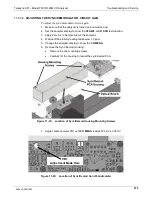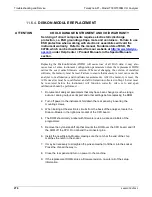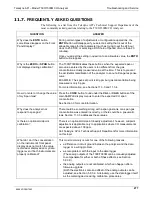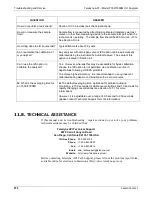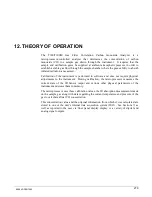
Troubleshooting and Service
Teledyne API – Model T300/T300M CO Analyzer
264
11.5.7.3.
OPTO PICKUP ASSEMBLY
Operation of the opto pickup PCA (P/N 04088) can be verified with a voltmeter.
Measure the AC and DC voltage between digital ground on the relay board, or
touchscreen and TP2 and TP4 on the sync pickup PCA. For a working board, with the
GFC motor spinning, they should read 2.4 ±0.1 VAC and 2.5 ±0.15 VDC.
Further confirmation that the pickups and motor are operating properly can be obtained
by measuring the frequency at TP2 and TP4 using a frequency counter, a digital
voltmeter with a frequency counter, or an oscilloscope, per Table 11-9.
Table 11-9:
Opto Pickup Board Nominal Output Frequencies
Nominal Measured Frequency
AC Mains Freq.
TP2
TP4
50 Hz
25
300
60 Hz
30
360
11.5.7.4.
GFC WHEEL DRIVE
If the D1 and D2 on the sync demodulator board are not flashing then:
1. Check for power to the motor by measuring between pins 1 and 3 on the connector
feeding the motor.
•
For instruments configured for 120 or 220-240VAC there should be
approximately 88 VAC for instruments configured for 100VAC, it should be the
voltage of the AC mains, approximately 100VAC.
2. Verify that the frequency select jumper, JP4, is properly set on the relay board.
•
For 50 Hz operation it should be installed.
•
For 60 Hz operation may either be missing or installed in a vertical orientation.
3. If there is power to the motor and the frequency select jumper is properly set then
the motor is likely bad.
•
See Section 11.6.2 for instructions on removing and replacing the GFC
assembly that the motor is bolted to.
11.5.7.5.
IR SOURCE
The IR source can be checked using the following procedure:
1. With the source disconnected, energize the analyzer and wait for it to start
operating.
•
Measure the drive Voltage between pins 1 and 2 on the jack that the source is
normally connected to; it should be 11.5 ± 0.25 VDC.
•
If not, then the problem is with the wiring, the relay board, or the +12V power
supply.
2. If the drive voltage is correct, then remove the source from the heat sink assembly
(2 screws on top) and connect to its mating connector.
•
Observe the light being emitted from the source.
•
It should be centered at the bottom of the U-shaped element.
•
If there is either no emission or a badly centered emission, then the source is
bad.
06864D DCN7562
Summary of Contents for T300
Page 2: ......
Page 182: ...06864D DCN7562 ...
Page 227: ...225 This page intentionally left blank 06864D DCN7562 ...
Page 228: ...06864D DCN7562 ...



